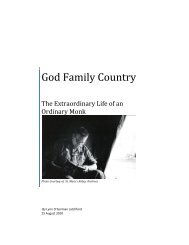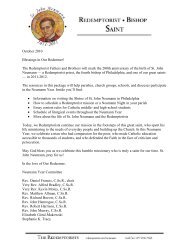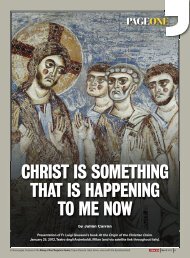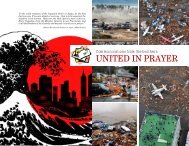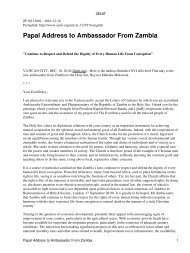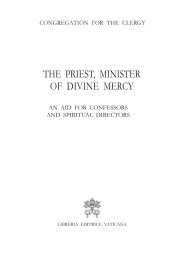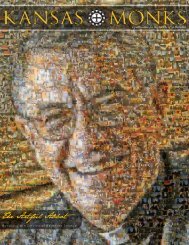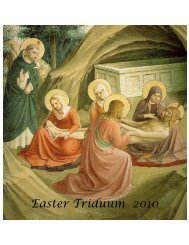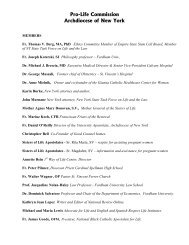The Conventual Franciscans History.pdf - Communio
The Conventual Franciscans History.pdf - Communio
The Conventual Franciscans History.pdf - Communio
You also want an ePaper? Increase the reach of your titles
YUMPU automatically turns print PDFs into web optimized ePapers that Google loves.
<strong>The</strong> <strong>Conventual</strong> <strong>Franciscans</strong>Celebrating 150 years of Gospel Life in NorthAmerica1852 - 2002Foundations in EuropeIn 1209, St. Francis of Assisi received formal approval from PopeInnocent III for his new way of life. He entitled his community the "FriarsMinor," a title literally meaning Lesser Brothers. St. Francis wanted hisfollowers to imitate the humility of Christ and to minister to the least insociety, to those of no account by the world's standards.But soon, Francis' pooling of religious men of such varied backgrounds,with so many talents and initiatives, led the community toward thebroader response of transforming every level of society. <strong>The</strong> friarsbecame preachers and educators, royal administrators of charity andadvocates of social justice. <strong>The</strong>y spread the faith far and wide asmissionaries, and spilled their blood as martyrs. <strong>The</strong> friars' expandinginfluence ultimately obligated them to sacramentalize even the world ofculture. As musicians they began to dispel the dullness of life, asarchitects they reached beyond the ordinary shapes and forms, and asscientists they explored the mysteries of the universe.After St. Francis' death, his movement was possessed of such a vitality,with so many opinions of how to live his form of Gospel life, that overtime it could not be contained in one community. In 1517, the Orderdecided to divide into autonomous branches, each professing a validperspective of their observance of his Rule.<strong>The</strong> "<strong>Conventual</strong>" followers of St. Francis chose to minister in the heartof the cities rather than in more remote hermitages. <strong>The</strong>y chose to bandtogether in concentrated communities, in large houses or friaries(conventus, from the Latin). From here they felt they could offer a moreconcentrated flow of ministry and live a life of regular observance of theirRule.<strong>The</strong> New WorldAlthough the friars had been missionaries to the East since the thirteenthcentury, by 1492 they felt it was time to explore any new worlds to theWest. Christopher Columbus, a Secular Franciscan, sought theadvocacy of the <strong>Conventual</strong> friars of the Rabida Friary in Seville, Spain.It was Friar Juan Perez, an astronomer, who pleaded Columbus' casebefore King Ferdinand, to whom he was financial advisor, and to Queen
Isabella, to whom he was confessor. Needless to say, the monarchswere won over. Friar Juan Perez was able to sail with Columbus on hissecond voyage in 1493. He is credited with celebrating the first Mass inthe New World.As time past, it would be another branch of the Franciscan Order thatwould evangelize the Spanish colonies of the Southwestern parts of theUnited States. <strong>The</strong> <strong>Conventual</strong> branch of the Order focused its attentionon the former British colonies of the East Coast.<strong>The</strong> United States<strong>The</strong> Napoleonic suppression of religious houses in 1803, devastated thelife and ministry of the friars in Germany. It was legislated that when thelast friar affiliated to a friary died, then that friary would become theproperty of the State. In 1839 only two friaries (Wurzburg and Schonau)were still possessed by the Order when the King of Bavaria overturnedNapoleon's degree and gave permission for the <strong>Conventual</strong>s there toreceive novices.Thus, the small and weakened community of German friars saw themissionary adventure to America as a great hope of continued rebirth. Itwould be a sacrifice, but the invitation of Bishop Jean Odin of Galveston,Texas initiated the missionary adventure of pastoral care for Germanand Polish immigrants. <strong>The</strong> first five friar missionaries were Fr.Bonaventure Keller, first superior of the mission; Fr. LeopoldMoczygemba, Fr. Anthony Mueller, Fr. Dominic Messens, and Br. GilesAugustin. <strong>The</strong>se daring men of German, Polish and Belgian ancestry,were given four parishes in Castroville, Fredericksburg, New Braunfels,and Ohanis. Twelve missions were attached to these parishes thatextended westward to California and south to Mexico.Between the 1780s - 1850s, several individual <strong>Conventual</strong> friarsministered to German immigrants in Baltimore, Philadelphia, Pittsburgh,Brooklyn, and Cincinnati. But it was not until they arrived in Texas onSeptember 14, 1852, when the <strong>Conventual</strong>s were able to establish defacto a permanent and abiding presence of the Order in North America.Two years after their arrival, in 1854, Bonaventure Keller was invitedEast to minister in Brooklyn, New York. <strong>The</strong>re he was responsible fortwenty-two mission stations, including the premier German parish ofHoly Trinity, currently on Montrose Avenue. In that same year, LeopoldMoczygemba was appointed as second superior of the mission. In 1858,the friars received permission to place the mission under the patronageof the Immaculate Conception (a Franciscan sponsored dogma that hadbeen declared four years earlier). That same year, John McCloskey, thefirst bishop of Albany, invited Moczygemba to send German friars toSyracuse and Utica to care for German Catholics. Since the number offriars in the country could not care for both the Texas missions and theEast Coast missions, it was decided to transfer all activity to the EastCoast. By 1859, the mission in Texas was failing. <strong>The</strong> territory was
terribly under-populated. <strong>The</strong> constant travel and basic exhaustion of thefriars had led them to discern that a settlement in the East, where theChurch was more settled, would be the wisest way to lay a solidfoundation for the Order. In the East there would be more availableresources and more vocational opportunities.It was also in 1859, that the motherhouse of the American mission wasestablished in Syracuse at Assumption Parish. A novitiate was alsoestablished there, and Assumption soon became well known for itsbeautiful liturgies and music. After this time, more and more missionstations were entrusted to the friars in upstate New York, and finally in1867, Our Lady of Angels parish was offered in the capital of Albany.<strong>The</strong> First ProvinceIn February of 1872, the General Administration in Rome felt that theAmerican mission was mature enough to become an autonomousProvince. Bonaventure Keller was elected the first provincial of the"Immaculate Conception" Province.In his first circular letter as provincial, Keller wrote, "Although the friarsare involved in many activities, the first and greatest activity is personalsanctification by means of religious observance." Basically, the friarswere very good pastoral laborers, but they had become accustomed toan independent lifestyle. Notwithstanding the immediacy of ministering toan overwhelming tide of immigrants, Keller passionately believed thatthe mission would be less fruitful if the friars neglected the regularobservance of their common life.Even as he worked to stabilize the community, Keller's health quicklydeclined and he died in office in 1877. Joseph Lessen was elected asthe second Provincial. Lessen also tried to convince the friars that theirconstant pastoral activity would limit their common religious strength. Hecommented that "frequently religious obligations are viewed by the friarsas impediments to ministry, as things that detract from work..." Thus,Lessen also challenged his confreres toward religious observance. Andit was actually Lessen's organizational skills that placed the youngprovince on a firm administrative foundation.In the 1880s there was a tremendous number of Polish immigrantscoming to the shores of America. Mostly of them being citizens of thethen German-Austrian controlled region of Poland, these peoplenaturally gravitated toward the German speaking parishes. Eventuallythis influx necessitated more Polish speaking friars. It was Friar HyacinthFudzinski, who was at the time ministering as a confessor at St. Peter'sin Rome, who was delegated to begin recruiting Poles for the Americanmission.Fudzinski soon returned to America himself and in 1895 he was electedthe fourth Minister Provincial. Fudzinski, a man of Polish-German origin,was diplomatically able to quell the growing tension between the Polish
and German friars. Fudzinski was praised for his pastoral zeal, his pietyand prudence. Through his tact and administrative efforts, Fudzinski alsoelevated the respect of ecclesiastical and civil leaders toward the friars.He and his successors accepted many debt-ridden parishes and throughyears of personal sacrifice and financial acumen they almostmiraculously stabilized every apostolate.New ProvincesAs early as 1852, the friars had welcomed Polish immigrants, the firstsettlement being Panna Maria, Texas (near San Antonio). In 1906 it wasdecided to establish a second American Province to specifically ministerto Polish immigrants. This new province, headquartered at Baltimore,would also help to stave off the terrible rift between the Church andthose Poles who were leaving to join the new "Polish National CatholicChurch." Although the <strong>Conventual</strong> friars were not able to settle thedivision completely, they were able to catechize well enough to welcomemany back into the fold.In succeeding years, three other jurisdictions were founded: in 1926 OurLady of Consolation Province in the Midwest was created with it'smotherhouse at Mount St. Francis, Indiana; St. Bonaventure Provincewas created in 1939 with its motherhouse at Chicago. And in 1981, aWest Coast Province was formed named after St. Joseph of Cupertino.An Expansion of <strong>Conventual</strong> HeritageIn the intervening years of continued immigration, the Depression andWorld Wars, the friars ministered at many secondary schools asteachers and administrators; they served as military, university, prison,and hospital chaplains; they established printing presses and foundedseveral publications. <strong>The</strong> friars have been pastoral and substance abusecounselors, itinerant preachers, directors of retreat centers, art'scolonies, and the sponsors of a radio station. <strong>The</strong>y have ministered inAIDS hospices and homeless shelters. <strong>The</strong>y have constructed housingfor the handicapped, founded a network of international shelters foryouth and runaways, have co-sponsored a Franciscan NGO Office (nongovernmentalorganization) at the United Nations, and have eveninitiated a wine making venture.Many Sisters' communities have been co-founded or aggregated to theAmerican <strong>Conventual</strong> Provinces. To name a few: Franciscan Sisters ofPerpetual Adoration, LaCrosse (aggre. 1870); Sisters of St. Francis ofAssisi, Milwaukee (aggre. 1900); Franciscan Sisters of St. Joseph (cofounded1909Sisters of the Third Order of St. Francis, Syracuse (aggre.1902); Sisters of the Blessed Sacrament, Cornwells Heights (aggre.1912); Sisters of Providence, Saint Mary-of-the-Woods (aggre. 1913).
<strong>The</strong> American Provinces of <strong>Conventual</strong>s have continued to water theirroots of evangelization by either founding or re-founding a number ofmissions, namely: England (1907), Brazil (1946), Costa Rica (1946),Zambia (1959), Central America (1970), Japan (1970), Canada (1976),Ghana (1976), Mexico (1977), and Denmark (1993). <strong>The</strong> American friarshave also generously assisted the international Order with ministry asconfessors in St. Peter's in Rome, and pilgrim leaders in Assisi.In keeping with their long heritage of cultural promotion, the friarsminister at various significant sanctuaries across the country: Our Ladyof Mount Carmel, located in El Paso, is the oldest Spanish mission inTexas; <strong>The</strong> National Shrine of St. Francis in San Francisco; St.Stanislaus Basilica in Chicopee, Massachusetts; St. Josaphat Basilica inMilwaukee, Wisconsin; the National Shrine of Blessed Kateri Tekawitha(Native American), Fonda, New York; the National Shrine of St.Maximilian Kolbe (Marytown), Libertyville, Illinois; and the NationalShrine of Our Lady of Consolation in Carey, Ohio.Significant American PersonalitiesBesides observing the feasts of the Franciscan saints in the universalcalendar, the <strong>Conventual</strong>s also retain a special memory of several otherAmerican friars. Friar Aloys Fish +1939, historian and preacher, wasalso a long time advocate for prison reform. Friar Dominic Szymanski+1951, was the co-founder of a printing apostolate in the spirit of St.Maximilian Kolbe. Friar Justin Figas +1959, was the founder of the radioprogram, "<strong>The</strong> Rosary Hour." He was also an advisor to PresidentRoosevelt regarding the German occupation of Poland during World WarII. Friar Casimir Cyphir + 1976, was a missionary in Honduras who wasbrutally martyred. Friar Frederick Gorka +1992, a man who escapedNazi aggression, spent his entire life dedicated to serving displacedimmigrants. He even founding an orphanage in Africa. And Friar JeremyChodacki, 1906- , one of the senior most friars in the country, was aprofessor and musician, who while a student in Cracow wascommissioned to compose the arrangement for the Israeli NationalAnthem.Minister Generals<strong>The</strong> American Provinces have also contributed to the internationaladministration of the Order with four men who have served as MinisterGenerals. <strong>The</strong>se men served with distinction at times of internationalcrisis. Friar Dominic Reuter (1904-1910), was the first American to beelected General and the 107th successor of St. Francis. He was actuallyborn in Germany, but immigrated to the States when he was three. FriarDominic held a doctorate in both philosophy and theology. During theFirst World War he was appointed to head the Vatican Office for warprisoners. Friar Bede Hess (1936-1953) served the Order during the
precarious year of the Second World War. Friar Bede was anintermediary between the Allied and Axis powers. He promoted culture,social works, and new missions in Latin America. Friar Basil Heiser(1960-1972) served during one of the most transforming events for theChurch of the modern era. <strong>The</strong> renewal of the Second Vatican Councilconfirmed his own beliefs that only reclaiming confiscated buildings wasnot enough to renew a lifestyle. During his many travels Friar Basilpromoted a reawakening of social ministry and cultural activities thatwere all to be balanced by a contemplative attitude. After his term, PaulVI named him to the position of Under-secretary to the Congregation forReligious. And even the third millennium was ushered in with theelection of an American, Friar Fr. Joachim Giermek (2001- ). FriarJoachim, the 118th successor to St. Francis, is a man of culture who isimbued with both a fraternal and professorial sense of hishis Franciscanheritage.–Friar Joseph Wood, OFM Conv._____________SourcesAlbum Generale. Ordinis Fratrum Minorum <strong>Conventual</strong>ium. Curia Generalizia. Rome, 2000.Geary, Daniel OFM Conv. Fr. Hyacinth Fudzinski OFM Conv. Unpublished paper, Christ the KingSeminary, Buffalo, New York, 1994.Kulbicki, Timothy OFM Conv. Early Development of the <strong>Conventual</strong> Franciscan Identity in theUnited States of America, 1852 - 1906. Doctoral Dissertation, Gregorian University, Rome. 1997.Smith, Jeremiah OFM Conv. <strong>History</strong> of the <strong>Conventual</strong> <strong>Franciscans</strong> in the United States, 1852 -1906. Order Minor <strong>Conventual</strong>s, Inc. Union City, New Jersey, 1988.



